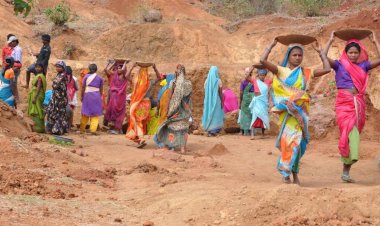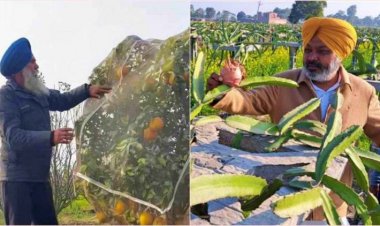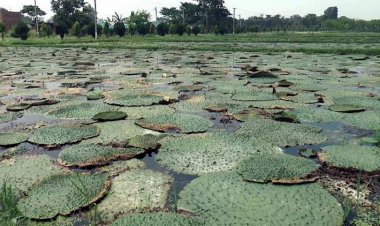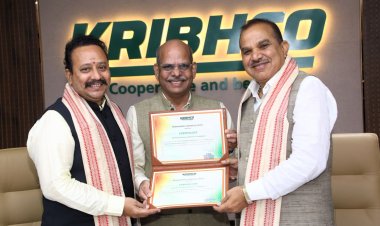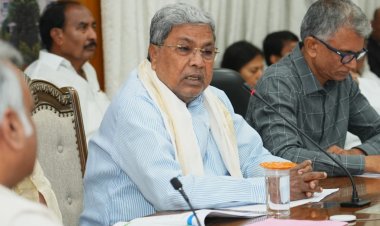SAP hike of only Rs 35 in 5 years and delay in its announcement: Does this indicate end of political lobbying on the part of cane farmers in UP?
Five years and a sugarcane price hike of only Rs 35; price hike announcement awaited for the sixth year; moreover, payments delayed by up to a year by several mills. Such a crop is enough to put any farmer in a financial crisis. This is the reality of the 45 lakh-odd sugarcane farmers in UP for whom the state fixes the SAP of sugar cane. When the BJP came to power in UP in 2017, it hiked the cane SAP by Rs 10 per quintal in the first season (2017-18). There was a price freeze for the next three years and it was only in the last year of its first term that the government hiked the SAP by Rs 25 per quintal to Rs 350 per quintal. The SAP announcement was made in the election year on 26 September 2021 even before the season started. On the other hand, the current season (2022-23) started in October 2022 and the cane farmers in the state are still waiting, as on 18 January 2023, for the SAP to be announced this season. The government is silent and even the sugar industry fails to understand why the government is not announcing the SAP.
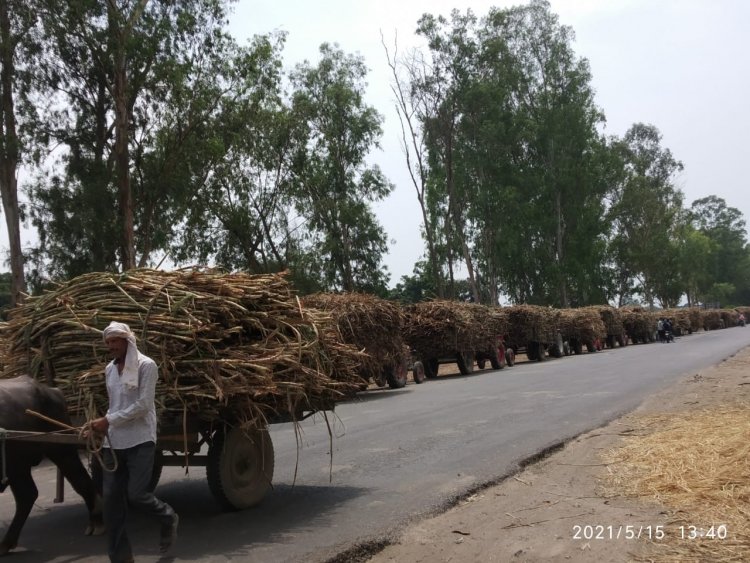
Five years and a sugarcane price hike of only Rs 35; price hike announcement awaited for the sixth year; moreover, payments delayed by up to a year by several mills. Such a crop is enough to put any farmer in a financial crisis. This is the reality of the 45 lakh-odd sugarcane farmers in Uttar Pradesh (UP) for whom the state fixes the State Advised Price (SAP) of sugar cane.
When the Bharatiya Janata Party (BJP) came to power in UP in 2017, it hiked the cane SAP by Rs 10 per quintal in the first season (2017-18). There was a price freeze for the next three years and it was only in the last year of its first term that the government hiked the SAP by Rs 25 per quintal to Rs 350 per quintal. The SAP announcement was made in the election year on 26 September 2021 even before the season started. On the other hand, the current season (2022-23) started in October 2022 and the cane farmers in the state are still waiting, as on 18 January 2023, for the SAP to be announced this season. The government is silent and even the sugar industry fails to understand why the government is not announcing the SAP.
If we speak of sugar production in the state, this will be the second year of lower production. The main reason behind this is a decline in productivity due to diseased crops, and farmers are suffering losses on this account, too. Besides, there is also a lower sugar recovery from the cane in the state.
Neither is the situation such that sugar mills can’t afford to pay higher prices. Barring those who are in financial trouble for other reasons, most of the sugar mills are making timely payments. In fact, some of them are making payments within a week of the cane supply. The profits of private sugar mills have risen and their share prices have gone up in the stock market substantially over the past two years.
Last year the country exported 110 lakh tonnes (lt) of sugar, for which the mills received Rs 40 per kg on average. Again, even for the current year, the government has allowed exports of 60 lt of sugar. Of this, about 18 lt of sugar has already been exported and contracts have been signed for 50 lt. According to industry sources, sugar mills are still getting a price of about Rs 40 per kg on exports.
As far as domestic prices are concerned, sugar mills in UP are getting ex-factory prices of Rs 36-37 per kg. The average price was Rs 34 per kg here last season while that in Maharashtra was Rs 32.50 per kg. The Union government has fixed the Minimum Selling Price (MSP) of sugar at Rs 31 per kg. However, the actual prices are much above the mark.
Besides, ethanol is emerging as a good alternative source of earning for the sugar mills. The government had increased ethanol prices recently. Also, oil marketing companies (OMCs) are making payments to the sugar mills within 21 days of the ethanol supply.
Thus, sugar mills are getting doubly benefited. One, exports are fetching better prices. The record exports are leading to less storage of sugar for sugar mills. As a large part of the sugar gets exported, the storage cost has reduced. And two, quick payments from ethanol sales are improving the mills’ situation on the cash front. This is why sugar mills are heading towards making ethanol directly from cane juice while some of them are making ethanol from B-heavy molasses. The prices of ethanol in both these categories are higher than those of ethanol made from C-heavy molasses. Ethanol made from cane juice directly is priced the highest.
About 45 lt of sugar was diverted towards making ethanol last season. This year about 60 lt of sugar will be diverted for this purpose. The production of sugar, including that diverted towards making ethanol, is estimated at 400 lt in the current season. However, if we exclude the diverted sugar, the production will come down to only 360 lt. The domestic market consumes about 280 lt of sugar.
The question that arises now is: Why is the UP government not announcing the SAP for the cane farmers and bringing about a hike? A probable answer is that the cane farmers have lost their political clout and are no more in a situation to create any sort of pressure on the government. Of course, a group of 45 lakh cane farmers should be quite important for any political party. But that the BJP government has returned to power in the state despite a mere Rs 35 hike in cane SAP in five years indicates the end of political lobbying on the part of cane farmers.
What is interesting is that there was a time when the difference between the Statutory Minimum Price (SMP) fixed by the Union government and the SAP fixed by the UP government would be up to 15-20 per cent. SMP has now been replaced by Fair and Remunerative Price (FRP). But now the difference between SAP and FRP is not much. And if we add the bonus given on FRP after the minimum sugar recovery of 10.25 per cent, the gap reduces further.
The Union government has fixed the FRP of sugar cane at Rs 305 per quintal for the current season. If the sugar recovery level exceeds 10.25 per cent, farmers are paid extra. If the recovery of sugar from the cane exceeds by 0.10 per cent, farmers will receive an additional payment of Rs 3.05 per quintal. States where cane price is given on the basis of FRP get the advantage from this. In UP, Uttarakhand, Punjab and Haryana, however, the payment is made on the basis of SAP.
While on the one hand, there has been a hike of only Rs 35 in six years in the state of UP, the production cost has steeply increased for the cane farmers on the other. Diesel prices have shot up by about Rs 20 per litre. Electricity has become more expensive. Pesticide prices have increased significantly, fertilizer prices have increased and labour cost has gone up. Such a situation has aggravated the economic plight of the cane farmers in UP. Besides, there are about two dozen sugar mills that are yet to make the cane pay price payments even for last season.
In order to mount pressure on the government with regard to a hike in SAP, the opposition is resorting to everything from rhetoric to agitation and the Rashtriya Lok Dal (RLD) is more active in this. The industry admits that farmers should receive higher prices but pleads its inability to pay such prices. It would be better if the government can extend some help in such a situation. The Akhilesh Yadav-led Samajwadi Party (SP) government had directly made cane price payments of more than Rs 2.5 crore to the farmers in one of the years. Which was part of SAP.
The farmers in the state do not have too many options either. Because even if the farmers adopt the crop cycle of wheat and paddy, it would be difficult for them to get the Minimum Support Price (MSP) due to the poor condition of the public procurement of foodgrains here. Given this situation, a large number of farmers accord priority to sugar cane.
One may get a glimpse here of how the SAP has increased in the state over the past few years. In terms of the SAP hike, the Mayawati-led Bahujan Samaj Party (BSP) government that came to power in 2007 proved to be the most effective. The SAP for sugarcane went up by Rs 120 during the tenure of the BSP government. The tenure of the subsequent Akhilesh Yadav-led SP government witnessed a hike of Rs 65 in the SAP. His government, too, had kept the SAP on freeze for three years.
The BJP government increased the SAP for sugar cane last year by Rs 25 per quintal for the 2021-22 crushing season. After the hike, the revised SAP was Rs 350 per quintal for the early variety of sugarcane, Rs 340 per quintal for the general variety and Rs 335 per quintal for the rejected variety.
When the Mayawati government came to power, the SAP was Rs 125 per quintal for the general variety and Rs 130 per quintal for the early variety in 2006-07. In the 2011-12 crushing season, the SAP had gone up to Rs 240 per quintal for the general variety and Rs 250 per quintal for the early variety. Thus, the SAP for the early variety of sugar cane witnessed a hike of Rs 120 per quintal during Mayawati’s tenure.
During the Akhilesh Yadav government, the SAPs for these two varieties went up from Rs 240 and Rs 250 per quintal in 2011-12 to Rs 305 and Rs 315 per quintal respectively in 2016-17, which was a hike of Rs 65 per quintal. On the other hand, the Yogi Adityanath-led BJP government hiked the cane SAP by Rs 10 per quintal in its first year. Thus, the SAP for the general variety went up to Rs 315 per quintal in 2017-18 while that for the early variety increased to Rs 325 per quintal. Subsequently, there was no hike in cane SAP for the crushing seasons of 2018-19, 2019-20 and 2020-21.
The Manohar Lal Khattar-led BJP government in the neighbouring state of Haryana had announced a cane SAP of Rs 362 per quintal for last season. But Haryana, too, is yet to announce the SAP this season and farmers are protesting even there with the demand for SAP hike. On the other hand, the Congress government in Punjab had announced the cane SAP at Rs 360 per quintal last season. And the Bhagwant Mann-led Aam Aadmi Party (AAP) government has raised it to Rs 380 per quintal.
Interestingly, currently in UP, one gets to see no big movement either on the issue of demand for SAP hike. However, farmers have protested against some of the sugar mills for not having made payments for last year.



 Join the RuralVoice whatsapp group
Join the RuralVoice whatsapp group


















